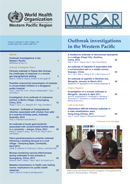An outbreak of syphilis in Darkhan-Uul, Mongolia, January to March 2012
DOI:
https://doi.org/10.5365/wpsar.2012.3.4.003Abstract
Background: Fifty-eight syphilis cases were notified from Darkhan-Uul Province in the first three months of 2012, which is double that of the same period in 2011. The objective of this investigation was to confirm the existence of the outbreak, examine the risk factors of cases and develop recommendations to prevent further spread.
Methods: We conducted a descriptive study of cases notified to the national surveillance system diagnosed with syphilis between 1 January and 20 March 2012 in Darkhan-Uul Province. Additional data were collected from doctors’ record books and outpatient cards. We compared outbreak cases to non-outbreak cases notified in Darkhan-Uul Province in 2011.
Results: The total notification rate was 62.3 per 100 000. The notification rate was highest among 20–29 year olds, and 38 (65.5%) were females. More males than females were detected through contact tracing (45% compared with 10.5%). Only 10% of cases reported using condoms during their last sexual encounter, with 65.5% reporting having had casual sex or multiple sex partners. There were no homosexual cases. Compared to the non-outbreak cases, outbreak cases had a significantly higher proportion of detection through contact tracing (22.4% compared with 0.7%) but a lower proportion of detection through prevention (3.5% compared with 26.5%). There was also a higher proportion of primary syphilis in outbreak cases (62.1% compared with 41.7%).
Conclusion: The syphilis outbreak in Darkhan-Uul Province was confirmed. We recommended effective contact tracing followed by timely diagnosis and treatment. Health promotion activities targeted to high school, college and university students on syphilis infection and prevention as well as condom usage were recommended for future prevention.

